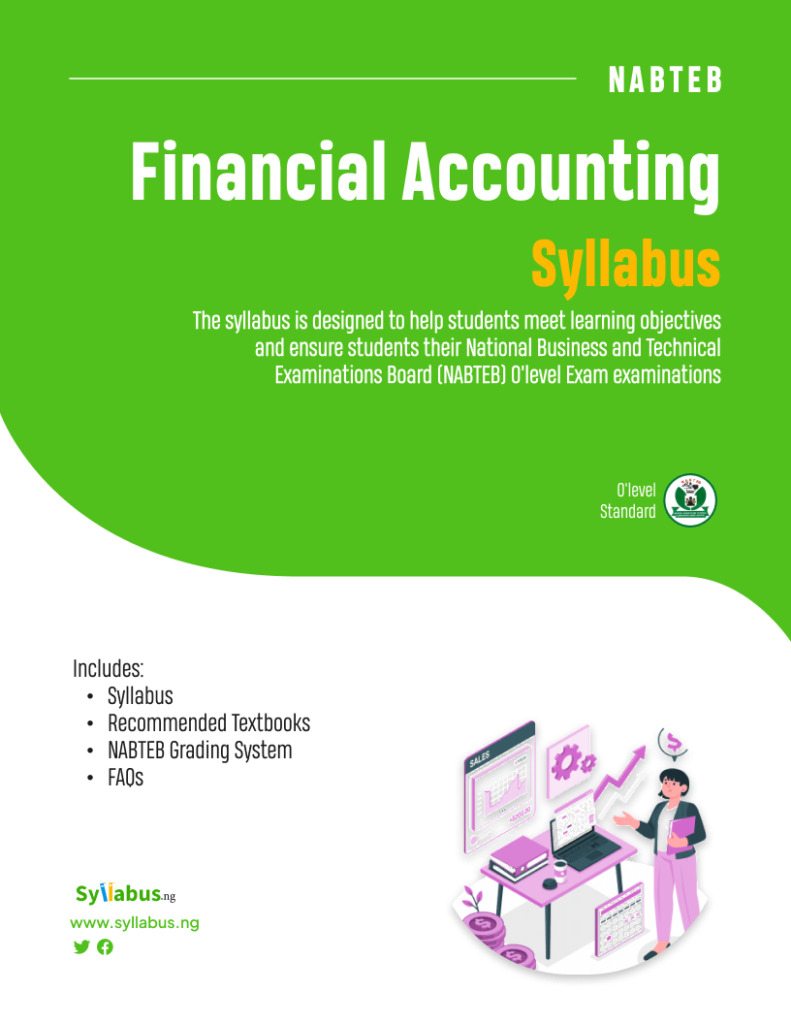Looking for useful information like study tips and materials on NABTEB Financial Accounting? Get in here!

Home » NABTEB Syllabus » NABTEB Financial Accounting SyllabusDo you know that as a student, studying smart guarantees you more success than studying hard?
Having a copy and reading this NABTEB syllabus for Financial Accounting is a smart way to study.
This syllabus gives you a hint on how your exam questions will look by showing you the full list of topics to study and what you are expected to know from each topic.
Your tutors at school won’t tell you about this smart move but this is where they get their study materials from. Stay ahead of the class by downloading and making this syllabus your study partner today!
The aim of this exam is to:
i. Provide the candidate with a deeper knowledge of the principles and methods of keeping financial records.
The exam will consist of just one paper which will last for 3 hours and 30 minutes. It will have two sections; A and B
Section A: will last for 1 hour and will contain a total of 50 multiple-choice questions. This section will carry 25% of the total marks.
Section B: will last for 2 hours 30 minutes duration. You will be given 7 questions and asked to answer 5.
This section will carry 75% of the total marks

Best candidates excel because they study smart and hard. Know what’s expected of you.
Download the NABTEB recommended Financial Accounting Syllabus
| NABTEB FINANCIAL ACCOUNTING SYLLABUS | ||
| SN | TOPICS | OBJECTIVES |
| 1 | THE ORIGIN OF BOOK-KEEPING & ACCOUNTS a) CONCEPTS & DIFFERENCES BETWEEN BOOK-KEEPING AND ACCOUNTS | i. Distinguish between Book-keeping and Accounts and explain the uses of various books of Account |
| 2 | ASSETS, LIABILITIES & CAPITAL | i. Explain assets, liabilities and capital and classify assets into current and fixed assets |
| 3 | DOUBLE ENTRY BOOK-KEEPING | i. Explain the principles of double entry and classify account into personal and impersonal. |
| 4 | BOOKS OF ORIGINAL AND SECONDARY ENTRY | i. Identify and explain various books of prime and secondary entries and post correctly from the books of original entries to the ledger. ii. Explain the uses of some sales documents. |
| 5 | THE CASH BOOK | i. Explain the columnal cash book ii. column and iii. column cash book), iv. post entries from the cash book to the ledger and determine the closing balance in the cash book. |
| 6 | THE JOURNAL | i. Explain Journal, its uses and its correct posting to ledger. |
| 7 | CONTROL ACCOUNT | i. Explain the uses of Control Accounts and solve questions on Financial Control Account. |
| 8 | IMPREST ACCOUNT | i. Describe the general format of a Petty Cash and prepare entries involving petty cash. |
| 9 | TRIAL BALANCE | i. Give the concept of a trial balance and identify disclosed and undisclosed errors. ii. Explain the procedure of identifying the disclosed and undisclosed errors by Trial Balance and prepare a Trial Balance from ledger |
| 10 | SUSPENSE ACCOUNT | i. Identify the uses and prepare a typical Suspense Account through solving giving problems. |
| 11 | ACCOUNTING CONCEPTS AND CONVENTION | i. Explain the concepts and convention in Accounting. |
| 12 | BANK RECONCILLATION AND STATEMENT | i. Explain the terms used in Bank Reconciliation and reasons for Differences in Bank Statement and Cash Book. ii. Prepare Bank Reconciliation Statement and Cash Book adjustment. |
| 13 | REVENUE AND CAPITAL EXPENDITURE | i. Identify Capital and Revenue expenditure and distinguish between current assets and current liabilities. ii. Prepare accounts involving Revenue and Capital Expenditure, Current assets and Current liabilities. |
| 14 | PREPAYMENT AND ACCURED EXPENSES | i. Explain Prepayment and Accrued Expenses and treat Prepayment and Accruals in the Books of accounts. |
| 15 | DEPRECIATION | i. Explain various methods of calculating depreciation and solve problems involving depreciations in the final Account. ii. Bad and Doubt Debt Explain and treat Bad and Doubtful debt in the books of account. |
| 16 | FINAL ACCOUNTS | i. Prepare simple final account. |
| 17 | PATNERSHIP TRANSACTION | i. Distinguish between Partnership, Company and Sole Trader. ii. State the requirements for formation of a partnership. iii. Prepare the final accounts of partnership business |
| 18 | BOOK-KEEPING ENTRIES RELATING TO INCOME TAX | i. Explain Income Tax and treat the book-keeping entries of tax for the Inland Revenue. |
| 19 | CONTAINERS ACCOUNT | i. Identify types of Containers Account and prepare Containers, Trading and Stock Account |
| 20 | MANUFACTURING ACCOUNTS | i. Prepare Manufacturing Accounts |
| 21 | SINGLE ENTRY & INCOMPLETE RECORDS | i. Distinguish between Single Entry and Incomplete records |
| 22 | ACCOUNTS OF NON-PROFIT MAKING ORGANIZATION | i. Receipts and payment accounts. ii. Income and Expenditure accounts. iii. Subscription in advance and in arrears. iv. Accumulated Fund. v. Preparation of Balance Sheet. |
| 23 | COMPANY ACCOUNTS | i. Explain Company Accounts. ii. Prepare Company accounts |
| 24 | DEPARTMENTAL & BRANCH ACCOUNTS | i. Explain Departmental and Branch Accounts ii. Prepare Departmental and Branch Account. |
| 25 | HIRE PURCHASE ACCOUNTS | i. Explain Hire Purchase Accounts. ii. Prepare Hire Purchase Accounts |
| 26 | CONSIGNMENT ACCOUNTS | i. Prepare consignment accounts. |
| 27 | JOINT VENTURE ACCOUNTS | i. Prepare joint venture accounts. |
| 28 | PUBLIC SECTOR ACCOUNTING | i. Explain the sources of Public Revenue |
| 29 | INTRODUCTION TO DATA PROCESSING | i. Historical Development of Computer ii. Basic elements, component, classification and functions of a Computer iii. Basic terminologies of a computer iv. Computer application in an Accounting environment |
1. Business Accounting Volume 1 – West African Edition by Frank Wood and Omunya.
2. Business Accounting Volume 2 – Frank Wood.
3. Accounting and Finance – Frank Wood.
4. Foundation Accounting – A. H. Millchamp.
5. Basic Accounting – J. D. Magee.
6. Accounting for Senior Secondary School – S. C. Malhorta, P. K. Botchweyand, P. A. Amankwah.
7. Accounting in Business – R. J. Bull.
8. Company Accounts – J. N. Amorin.
9. Principles of Accounting – K. B. Appiah Mensah
10. Incorporated Private Partnership Act 1962, Act 152
The most important thing is for you to read and understand each question before you start writing your answer.
Watch out for the instructions as well.
The theory section usually carries more marks than the other section, so make sure you give yourself enough time to answer all the questions in this section.
Instead of reading to memorize, reading to understand. That way you can be able to explain things in your own words and the official marking your scripts will know that you truly understand the subject.
As a general rule, you should spend no more than 2 minutes on each question in the objective section and 5 minutes on the theory. However, it’s important to keep an eye on the clock and make sure you’re spending an appropriate amount of time on each question. You don’t want to rush through and make careless mistakes!
If you’re running out of time, don’t panic! Try to finish as many questions as possible and make sure your answers are as complete as possible.
If you’re unsure about a question, skip it and move on to other questions you understand and can answer. Then come back to those you don’t understand and think about it some more. Don’t spend too much time on a question that is confusing you. It’s better to focus on questions that you are more confident about.
Yes, you will be allowed to use a calculator.

Best candidates excel because they study smart and hard. Know what’s expected of you.
Download the NABTEB recommended Financial Accounting Syllabus